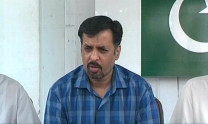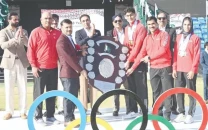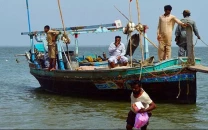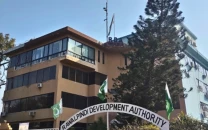Harbinger of change: Sindh's expecting mothers can soon use app to check health risks
Mobile application being developed by NGO to help detect pregnancy complications in remote areas

Poverty Eradication Initiative Executive Director Shahid Masood Yousaf
To tackle the issue, a mobile application is being developed which will help community midwives (CMW) determine the complication of a pregnancy in remote areas of Sindh.
CMWs are specially trained nurses whose job is to help women when they're having a baby. This application is being developed by a non-profitable organisation, Poverty Eradication Initiative (PEI).
PEI is a non-political, non-partisan and non-profit organisation working as a facilitator to initiate and sustain women and children-oriented developmental processes both at policy and community level on a partnership basis.
Unqualified medics playing with mothers, infants’ lives in Punjab
The firm's registered office is located in Peshawar. PEI has been set up by individuals, mainly from Khyber Pakhtunkwa (KP) residing in Canada and the United States, who came together in 1998 to support initiatives to improve quality of life of common citizens with a focus on family and society.
The organisation was formally created in 2002. Currently, it is one of the five largest non-governmental organisation's (NGO) in Pakistan. It has raised $110 million for social sector initiatives in Pakistan.
Speaking to The Express Tribune in his office in Clifton, PIE Executive Director Shahid Masood Yousaf said that PIE has been working on a new concept, 'Clinical Decision Support System', with the help of artificial intelligence and software. "This support system will determine whether a pregnancy will turn out to be complicated or normal," Yousaf said.
On the rise: No significant improvement in fighting anaemia in Sindh
He explained that in the early stages, the NGO's activities were mainly concentrated in KP and Balochistan. After the Thar crisis, he said, the NGO supported the Sindh government.
Taj Haider from the Pakistan Peoples Party was the coordinator of the Thar Relief programme. After the programme, Yousaf said a meeting was held in Islamabad with Haider to come up with a mechanism in Sindh. "It took two-and-a-half years in dialogue before the government agreed to move forward," said Yousaf.
The biggest public-private partnership contract in the social sector was established under the name of the Sindh Medical Support Programme, which was later renamed to the Sindh People Health Programme. At a cost of $50 million, 70% of the programme will be funded by PIE, while the cost of the remaining 30% will be borne by the Sindh government.
The programme has four big components, all of which will be functional by year end, said Yousaf. The first one is to enhance the capacity building of 4,500 lady health workers (LHW) in Sindh out of 22,000.
Mothers’ day: Maternal healthcare remains neglected
The Lady Health Worker Programme was introduced in Pakistan in 1993 in order to make primary healthcare accessible to women who are confined to their homes, and to effectively administer immunisation campaigns among children.
For the second component, 300 new birthing setups will be established in the six districts of Sindh, Larkana, Khairpur, Thatta, Mirpukhas, Hyderabad and Dadu and they will upscale around 150 of the current birthing setup. "Normal pregnancies can be entertained at the villages 24/7," he said.
When asked about the complications women in such districts face during pregnancy, which often compels them to opt for a C-section, Yousaf explained about the mobile application and Clinical Decision Support System.
It took them three years to develop this application. In the mobile application, the CMW, who will be trained on how to use the application, will enter the blood and urine analysis of the patient along with her family history.
"The data entered with artificial intelligence will analyse risk factors," he said, adding that there will be 100 different data points and 10 different risk factors of pregnancy. "Every data point has a link with the risk factor," he said.
Ambulance service for expecting mothers launched in Lahore
There will be a colour with the name of the patient in the mobile phone. If the colour remains green, it would mean that the pregnancy is normal. If it turns yellow or orange, it would mean that there are some complications and the patient must be referred to a doctor. If the colour turns red, Yousaf said it would signify that the patient should rush to a hospital.
The next problem for the patients would be of access to an ambulance, for which PIE has already identified nearby ambulance services and other modes of transport. "In case of an emergency, such services will immediately receive a message and whosoever responds initially, will take the patient to the hospital," he said, adding that a referral system was being prepared for the transportation. The doctors and LHWs will also have access to the data in the hospital.
The third component is of child health and child protection, which will be launched with 6,000 families and children. "It will be the largest child protection programme in the country," he said.
The fourth component is functional in many big hospitals and district headquarters hospitals of the province. "We have established 50 counters in different hospitals where medical and surgical supplies from US are provided to the needy," he said.



















COMMENTS
Comments are moderated and generally will be posted if they are on-topic and not abusive.
For more information, please see our Comments FAQ